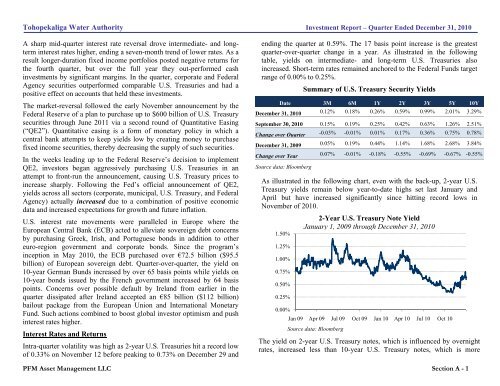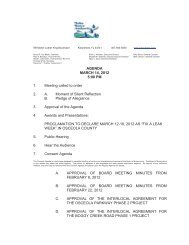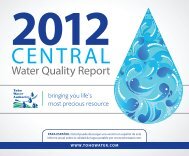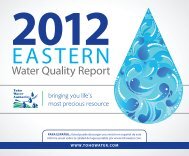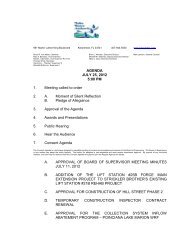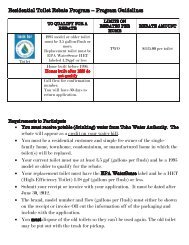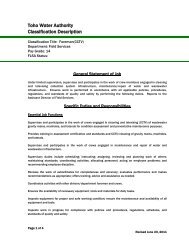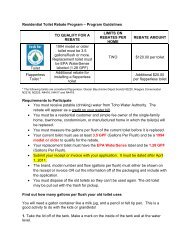AGENDA MARCH 9, 2011 5:00 PM 1. Meeting called to order 2. A ...
AGENDA MARCH 9, 2011 5:00 PM 1. Meeting called to order 2. A ...
AGENDA MARCH 9, 2011 5:00 PM 1. Meeting called to order 2. A ...
You also want an ePaper? Increase the reach of your titles
YUMPU automatically turns print PDFs into web optimized ePapers that Google loves.
Tohopekaliga Water Authority Investment Report – Quarter Ended December 31, 2010A sharp mid-quarter interest rate reversal drove intermediate- and longterminterest rates higher, ending a seven-month trend of lower rates. As aresult longer-duration fixed income portfolios posted negative returns forthe fourth quarter, but over the full year they out-performed cashinvestments by significant margins. In the quarter, corporate and FederalAgency securities outperformed comparable U.S. Treasuries and had apositive effect on accounts that held these investments.The market-reversal followed the early November announcement by theFederal Reserve of a plan <strong>to</strong> purchase up <strong>to</strong> $6<strong>00</strong> billion of U.S. Treasurysecurities through June <strong>2011</strong> via a second round of Quantitative Easing(“QE2”). Quantitative easing is a form of monetary policy in which acentral bank attempts <strong>to</strong> keep yields low by creating money <strong>to</strong> purchasefixed income securities, thereby decreasing the supply of such securities.In the weeks leading up <strong>to</strong> the Federal Reserve’s decision <strong>to</strong> implementQE2, inves<strong>to</strong>rs began aggressively purchasing U.S. Treasuries in anattempt <strong>to</strong> front-run the announcement, causing U.S. Treasury prices <strong>to</strong>increase sharply. Following the Fed’s official announcement of QE2,yields across all sec<strong>to</strong>rs (corporate, municipal, U.S. Treasury, and FederalAgency) actually increased due <strong>to</strong> a combination of positive economicdata and increased expectations for growth and future inflation.U.S. interest rate movements were paralleled in Europe where theEuropean Central Bank (ECB) acted <strong>to</strong> alleviate sovereign debt concernsby purchasing Greek, Irish, and Portuguese bonds in addition <strong>to</strong> othereuro-region government and corporate bonds. Since the program’sinception in May 2010, the ECB purchased over €7<strong>2.</strong>5 billion ($95.5billion) of European sovereign debt. Quarter-over-quarter, the yield on10-year German Bunds increased by over 65 basis points while yields on10-year bonds issued by the French government increased by 64 basispoints. Concerns over possible default by Ireland from earlier in thequarter dissipated after Ireland accepted an €85 billion ($112 billion)bailout package from the European Union and International MonetaryFund. Such actions combined <strong>to</strong> boost global inves<strong>to</strong>r optimism and pushinterest rates higher.Interest Rates and ReturnsIntra-quarter volatility was high as 2-year U.S. Treasuries hit a record lowof 0.33% on November 12 before peaking <strong>to</strong> 0.73% on December 29 andending the quarter at 0.59%. The 17 basis point increase is the greatestquarter-over-quarter change in a year. As illustrated in the followingtable, yields on intermediate- and long-term U.S. Treasuries alsoincreased. Short-term rates remained anchored <strong>to</strong> the Federal Funds targetrange of 0.<strong>00</strong>% <strong>to</strong> 0.25%.Summary of U.S. Treasury Security YieldsDate 3M 6M 1Y 2Y 3Y 5Y 10YDecember 31, 2010 0.12% 0.18% 0.26% 0.59% 0.99% <strong>2.</strong>01% 3.29%September 30, 2010 0.15% 0.19% 0.25% 0.42% 0.63% <strong>1.</strong>26% <strong>2.</strong>51%Change over Quarter -0.03% -0.01% 0.01% 0.17% 0.36% 0.75% 0.78%December 31, 2<strong>00</strong>9 0.05% 0.19% 0.44% <strong>1.</strong>14% <strong>1.</strong>68% <strong>2.</strong>68% 3.84%Change over Year 0.07% -0.01% -0.18% -0.55% -0.69% -0.67% -0.55%Source data: BloombergAs illustrated in the following chart, even with the back-up, 2-year U.S.Treasury yields remain below year-<strong>to</strong>-date highs set last January andApril but have increased significantly since hitting record lows inNovember of 2010.2-Year U.S. Treasury Note YieldJanuary 1, 2<strong>00</strong>9 through December 31, 2010<strong>1.</strong>50%<strong>1.</strong>25%<strong>1.</strong><strong>00</strong>%0.75%0.50%0.25%0.<strong>00</strong>%Jan 09 Apr 09 Jul 09 Oct 09 Jan 10 Apr 10 Jul 10 Oct 10Source data: BloombergThe yield on 2-year U.S. Treasury notes, which is influenced by overnightrates, increased less than 10-year U.S. Treasury notes, which is morePFM Asset Management LLC Section A - 1


